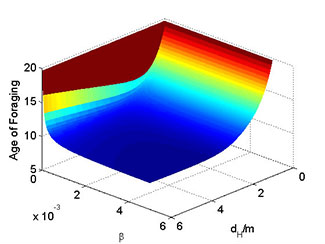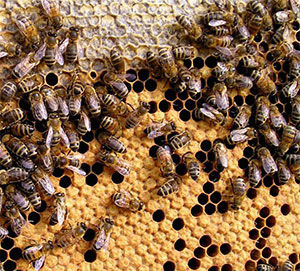A New Equation for Pi(e): How Applied Math can Save the Bees
 Matthew Betti loves strawberry-rhubarb pie so much, he’s devoted his PhD studies to protecting it.
Matthew Betti loves strawberry-rhubarb pie so much, he’s devoted his PhD studies to protecting it.
Narrow focus? Maybe, but Betti, a PhD candidate in Applied Mathematics at Western Science, is thinking about the rest of us, too.
A convergence of factors is threatening once-healthy honeybee hives across Canada and, without their pollinating powers, we could see a future with no strawberries or rhubarb.
Beyond pie, it’s an important problem to solve: The honeybees which pollinate our food crops are responsible for over $13 billion in agriculture worldwide, every year.
“Without bees,” says Betti, “you’d either have fruits that are prohibitively expensive at the supermarket or non-existent. Apples, berries and even broccoli will become rare. Without the bees, there will be no more apple pie.”
It’s a problem that Betti says is getting worse, and it's a problem that applied math can solve.
Math you can use!
 Betti has an answer for the most-asked question in any high school math class: “But how are we going to use this in the real world?”
Betti has an answer for the most-asked question in any high school math class: “But how are we going to use this in the real world?”
Betti turns the real world into a set of equations and identifies patterns. Last summer, he developed a mathematical model using data from field biologists and discovered that when something is threatening the colony, forager bees leave the hive at a young age.
In normal conditions, forager bees leave the hive at 14 days old. They do the important work of gathering food to bring back to the hive, and pollinate crops in the process.
But in adverse conditions, an unsustainable cycle ensues: the hive pushes out younger and younger bees in a desperate attempt to get more food and save itself. Most of the young bees don’t make it and, eventually, the whole colony collapses.
“It’s like sending a teenager out into the world,” Betti says. “The human may survive but a 9-day old bee is not likely to make it.”
Betti’s mathematical model has resulted in a valuable warning sign that farmers can use now to make decisions in the field: If they see a lot of young bees flying out of the hive, they can act quickly and test for disease, isolate a particular hive, or cull healthy bees and transfer them to a new hive.
Seeing the Forest Through the Trees
Betti’s work leading to this important indicator of hive health, published in June PLOS ONE, Volume 9, in collaboration with Professors Lindi Wahl and Mair Zamir, is at the frontlines of population modeling for bees.
His next step is designing a more complex mathematical model that could reveal multiple indicators of hive health.
“The beauty of math is that numbers are just numbers,” he says. “Our equations look like nonsense to most people, but computer models can crunch a lot of data to find patterns. We really can help people see the forest through the trees.”
Betti talks about standing at the top of the stairs at 5:00 p.m. in Toronto’s busy Bloor/Young subway station. Looking down, all of the people appear as one big mass. Looking closer, he sees patterns: people in suits head southbound, people in jeans tend to go westbound.
His new work takes a similar view from the top. By grouping bees by age, he can see patterns among bees at one day old, two days old and onward through their life cycle.
This more complex model allows Betti to accurately capture activity. If he can understand hive patterns, he can correlate behavior to threats, whether that’s pesticides or infection.
Pesticides an Easy Target
 Although pesticides have been in the news lately as the biggest threat to bee health, Betti says that current scientific studies point to a combination of factors causing overwintering losses of up to 29 percent of hives, as reported by Health Canada.
Although pesticides have been in the news lately as the biggest threat to bee health, Betti says that current scientific studies point to a combination of factors causing overwintering losses of up to 29 percent of hives, as reported by Health Canada.
“We should also be looking at infections and farming practices,” he says. “The big farms, the ones that require bees most to pollinate their crops, still tend to work in a very industrial manner.”
Industrial farms plant acres and acres of a single crop -- giving bees access to plentiful food, but only one kind of food -- and then take it all away at harvest. The lack of biodiversity and stable food source results in weaker bees.
Infections, parasites and pests are other significant factors, Betti says. “There are a million different travel routes for people, fruits, vegetables. Any disease spreads faster these days because of how much people and goods are travelling.”
Although farmers directly control pesticides, they can’t simply stop or infestations will kill the crops we need. Betti notes that studies are underway to determine optimal pesticide use for both bee and crop health.
It will take a while to see improvements, even if all of these factors are addressed. In the meantime, Betti is confident we can have our pie and eat it too if we start using math models to optimize hive health now.
“We’re finding warning signs so we can prevent an impact rather than react to one,” he says. “If we do things right, and do them now, no one will see a change in their everyday lives.”
“You know we’ve failed if you go to the supermarket and they laugh when you ask for apples.”

